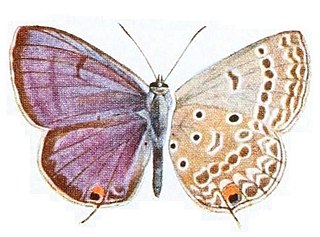
Halimium is a genus of 12 species of evergreen or semi-evergreen subshrubs in the family Cistaceae, closely related to Cistus. They are native to Europe, North Africa and Asia Minor, with the centre of diversity in the western Mediterranean region.

Xylophanes tersa, the tersa sphinx, is a moth of the family Sphingidae. The species was first described by Carl Linnaeus in 1771. It is found from the United States, through Mexico, the West Indies and Central America and into parts of South America. An occasional stray can be found as far north as Canada.

Spermacoce or false buttonweed is a genus of flowering plants in the family Rubiaceae. It comprises about 275 species found throughout the tropics and subtropics. Its highest diversity is found in the Americas, followed by Africa, Australia and Asia.

Caryocolum fischerella is a moth of the family Gelechiidae. It is found in central and northern Europe.

Hippotion boerhaviae, the pale striated hawkmoth, is a moth of the family Sphingidae.
Parafomoria halimivora is a moth of the family Nepticulidae. It is found in the Iberian Peninsula.

Basiothia medea, the small verdant hawk, is a moth of the family Sphingidae. It is common in open habitats throughout the Ethiopian Region, including Madagascar. It is however probably absent from the equatorial forest belt, except as a vagrant. The species is an active migrant.
Coleophora nubivagella is a moth of the family Coleophoridae. It is found from Germany and Poland to the Pyrenees, Italy, North Macedonia and Romania.

Lepidochrysops quassi, the tailed blue giant Cupid, is a butterfly in the family Lycaenidae. It is found in Ivory Coast, Ghana, Togo, Nigeria and Cameroon. Its habitat consists of open areas in the forest zone.

Halimium ocymoides, the basil-leaved rock rose, is a species of flowering plant in the family Cistaceae, native to Portugal and Spain in the Iberian Peninsula, and northern Morocco in Northwest Africa. It is an erect evergreen shrub growing to 60 cm (24 in) tall by 100 cm (3 ft) wide, with woolly grey-green leaves and bright yellow flowers in spring. The flowers may have a dark brown blotch at the base of each petal.

Syngamia florella, the orange-spotted flower moth or red waisted florella moth, is a moth of the family Crambidae. It was described by Caspar Stoll in 1781. It is found from South Carolina to Florida and from Arkansas to Texas, south to the West Indies and through Mexico to Argentina. It is also found on Bermuda.
Spermacoce neoterminalis, the Everglades Key false buttonweed, is a species of plant in the Rubiaceae. It is endemic to southern Florida, from the Everglades as far north as Lake Okeechobee.
Spermacoce ovalifolia, the broadleaf false buttonweed, is a species of plants in the Rubiaceae. It is native to Mexico, Central America, parts of the Caribbean, and South America.
Spermacoce keyensis, the Florida false buttonweed, is a species of plants in the family Rubiaceae, first discovered in the Florida Keys. It is found in southern Florida, Bahamas, and the extreme southern tip of Texas.

Spermacoce alata, the winged false buttonweed, is a species of plant in the Rubiaceae. It is widespread across the warmer parts of the Western Hemisphere and naturalized in many other parts of the world.
Spermacoce glabra, smooth false buttonweed, is a New World species of plants in the coffee family.
Spermacoce prostrata is a species of plants in the Rubiaceae. In the United States, it is widespread in Florida, with a few isolated populations in Alabama and Mississippi. The species is native to Mexico, Central America, the Caribbean (Bahamas, Cuba, Hispaniola, Puerto Rico, Trinidad, Turks & Caicos, the Lesser Antilles, and the Dutch and Venezuelan Antilles. It is also widespread in South America, found in every country except Chile. The species is reportedly naturalized in Hawaii, China, Japan, Taiwan, Sri Lanka, Thailand and Java.

Spermacoceae is a tribe of flowering plants in the family Rubiaceae and contains about 1346 species in 57 genera. Its representatives are found in the tropics and subtropics.

Perilla is a genus consisting of one major Asiatic crop species Perilla frutescens and a few wild species in nature belonging to the mint family, Lamiaceae. The genus encompasses several distinct varieties of Asian herb, seed, and vegetable crop, including P. frutescens (deulkkae) and P. frutescens var. crispa (shiso). The genus name Perilla is also a frequently employed common name ("perilla"), applicable to all varieties. Perilla varieties are cross-fertile and intra-specific hybridization occurs naturally. Some varieties are considered invasive.

Spermacoce verticillata, the shrubby false buttonweed, is a species of plant in the family Rubiaceae.












